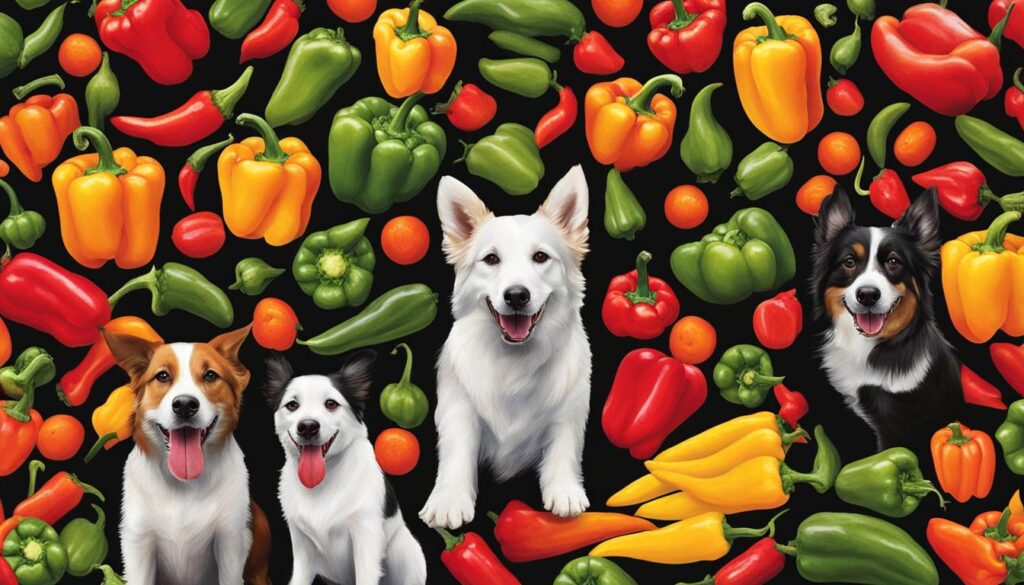Can Dogs Have Red Bell Peppers? Safety & Benefits
When it comes to sharing our favorite foods with our furry friends, it’s important to understand what is safe and healthy for them. One food that often sparks curiosity is red bell peppers. Can dogs have red bell peppers? The answer is yes! Red bell peppers are not only safe for dogs to eat, but they also provide several health benefits.
Red bell peppers are packed with essential vitamins and antioxidants that support a dog’s immune system, skin, coat, and eye health. They are rich in vitamins A, E, B6, and lutein. Vitamin C and beta-carotene, both important antioxidants, are also found in abundance in red bell peppers. These nutrients contribute to a dog’s overall well-being and can help strengthen their natural defenses.
While it’s exciting to introduce new foods to our pets, it’s essential to do so gradually and in moderation. This applies to red bell peppers as well. Start by offering small amounts of bell pepper to your dog to gauge their reaction. Monitor for any signs of digestive upset, such as vomiting or diarrhea. It’s always a good idea to consult with your veterinarian before making any significant changes to your dog’s diet.
It’s important to note that while red bell peppers are safe for dogs, certain preparations and additions should be avoided. Seasonings, salt, onions, garlic, and spicy varieties should never be included when feeding bell peppers to dogs. These ingredients can be harmful to dogs and may cause adverse reactions.
Key Takeaways:
- Red bell peppers are safe for dogs to eat and offer several health benefits.
- They are rich in vitamins A, E, B6, and lutein, as well as vitamin C and beta-carotene.
- Introduce bell peppers slowly and in moderation to avoid digestive upset.
- Avoid seasonings, salt, onions, garlic, and spicy varieties when feeding bell peppers to dogs.
- Consult with a veterinarian before making any significant changes to your dog’s diet.
Nutritional Value of Red Bell Peppers for Dogs
Red bell peppers are packed with nutrients that provide numerous health benefits for dogs. They are not only delicious, but they also contain essential vitamins and antioxidants that support a dog’s overall well-being.
Here are some key nutrients found in red bell peppers:
- Vitamin A: Red bell peppers are a rich source of vitamin A, which plays a crucial role in maintaining a dog’s vision, immune system, and skin health.
- Vitamin E: Red bell peppers are also high in vitamin E, an antioxidant that helps protect a dog’s cells from damage and boosts their immune system.
- Vitamin B6: This vitamin promotes healthy brain function and aids in the production of red blood cells.
- Lutein: Red bell peppers contain lutein, a natural antioxidant that supports eye health, particularly in older dogs.
- Vitamin C: Red bell peppers are an excellent source of vitamin C, which is essential for collagen production, immune system function, and overall vitality.
- Beta-Carotene: Red bell peppers are packed with beta-carotene, which the body converts into vitamin A. Beta-carotene is an antioxidant that helps protect against cellular damage.
Including red bell peppers in your dog’s diet can provide them with these valuable nutrients, supporting their immune system, skin, coat, and eye health.
It’s important to note that while red bell peppers can be beneficial for dogs, they should always be given in moderation and as part of a balanced diet. Consulting with a veterinarian is recommended before introducing any new foods to your dog’s routine.
Can Dogs Eat Different Colored Bell Peppers?
Dogs can safely enjoy a variety of colored bell peppers, including green, yellow, orange, and red. These vibrant vegetables not only add color to their diet but also offer several health benefits. Each color has its own nutritional profile, with red bell peppers being the most nutritious due to their longer ripening time.
It is important to note that dogs should avoid consuming spicy peppers, such as jalapeños or chili peppers, as they can cause discomfort and irritation.
| Bell Pepper Color | Nutritional Benefits |
|---|---|
| Green | High in vitamin C, fiber, and antioxidants. Supports immune function. |
| Yellow | Rich in vitamin C, folate, and antioxidants. Promotes eye health and boosts immunity. |
| Orange | Contains vitamin A, vitamin C, and beta-carotene. Supports healthy skin and coat. |
| Red | Packed with vitamin A, vitamin E, vitamin B6, and lutein. Boosts immune system and promotes overall well-being. |

While all colors offer health benefits, red bell peppers reign supreme due to their higher nutritional content. Therefore, if you have the option, it is recommended to include red bell peppers in your dog’s diet more frequently.
Remember, it is crucial to introduce bell peppers gradually and in moderation. Always consult with your veterinarian before making any changes to your dog’s diet.
How to Prepare Bell Peppers for Dogs
When it comes to incorporating bell peppers into your dog’s diet, preparation is key. The way you prepare bell peppers can make them easier for dogs to consume and digest. Here are some important steps to follow:
- Steam or Puree: To make bell peppers more palatable for dogs, you can steam or puree them. This softens the outer skin, making it easier for dogs to chew and digest.
- Remove Seeds and Stems: Before serving bell peppers to your furry friend, it’s crucial to remove the seeds and stems. These parts can be difficult for dogs to digest and may cause digestive issues.
- Serve Plain: Bell peppers should be served plain, without any seasoning, salt, onions, or garlic. While these ingredients may be tempting to add for flavor, they can be harmful to dogs and should be avoided.
Remember, every dog is different, and it’s important to introduce new foods into their diet gradually. Always consult your veterinarian before making any significant changes to your dog’s diet, including the introduction of bell peppers.

Benefits of Steaming or Pureeing Bell Peppers for Dogs
Steaming or pureeing bell peppers provides several benefits for dogs. Firstly, it makes the peppers easier to eat and digest, especially for dogs with sensitive stomachs or dental issues. This preparation method also helps release more of the nutrients present in the bell peppers, maximizing their health benefits for your furry companion.
Sample Table: Comparative Nutritional Content of Raw and Cooked Bell Peppers
| Bell Pepper Type | Nutrient | Raw (per 100g) | Cooked (per 100g) |
|---|---|---|---|
| Red Bell Pepper | Vitamin A | 1577 IU | 1415 IU |
| Vitamin C | 127.7 mg | 105.2 mg | |
| Green Bell Pepper | Vitamin A | 868 IU | 765 IU |
| Yellow Bell Pepper | Vitamin A | 810 IU | 511 IU |
This sample table demonstrates the comparative nutritional content of raw and cooked bell peppers. It showcases the retention of essential vitamins, such as Vitamin A and C, when bell peppers are cooked. However, some nutrients may decrease slightly during the cooking process.
Recommended Amount of Bell Peppers for Dogs
Dogs should be fed bell peppers in moderation to ensure their overall well-being. The recommended amount of bell peppers for dogs varies based on their size. For large dogs, it is advisable to feed them less than one-half of a bell pepper per serving. Conversely, for small dogs, it is best to limit their consumption to less than one-quarter of a bell pepper per serving.
Feeding bell peppers in excess of these recommended amounts may lead to digestive issues, such as upset stomach, vomiting, or diarrhea. It is crucial to carefully monitor your dog’s reaction after introducing bell peppers into their diet. If any digestive issues occur, it is recommended to consult a veterinarian for guidance and assistance.
| Dog Size | Recommended Amount of Bell Peppers |
|---|---|
| Small Dogs | Less than one-quarter of a bell pepper |
| Large Dogs | Less than one-half of a bell pepper |
Bell peppers are a healthy addition to a dog’s diet, but it is essential not to exceed the recommended amounts to prevent any adverse effects on their digestive system.
Can Dogs Eat Spicy Peppers?
Dogs should not be fed spicy peppers, such as jalapeños or chili peppers. Spicy peppers contain capsaicin, which can cause irritation and discomfort for dogs. It is best to avoid giving dogs any peppers that cause a hot, burning sensation. If a dog accidentally consumes a spicy pepper, monitor for symptoms of illness and consult a veterinarian if necessary.
Italicized text: Spicy peppers should not be part of a dog’s diet as they can cause discomfort and irritation.
Conclusion
In conclusion, dogs can safely enjoy the benefits of red bell peppers in their diet. These vibrant vegetables are not only safe for dogs to eat, but they also offer numerous health advantages. Red bell peppers are rich in essential vitamins such as A, E, B6, and C, as well as antioxidants like lutein and beta-carotene, which promote a strong immune system and overall canine well-being.
When introducing red bell peppers to a dog’s diet, it is crucial to do so gradually and in moderation. While these nutritious vegetables provide a range of benefits, it’s important to avoid any seasoning, salt, onions, garlic, or spicy pepper varieties, as they can cause digestive issues and discomfort for dogs.
As with any dietary changes, it’s always wise to consult a veterinarian before incorporating red bell peppers or any new food into a dog’s diet. Veterinarians can offer personalized guidance and ensure that the addition of red bell peppers aligns with a dog’s specific health needs. By following these guidelines and seeking professional advice, owners can enhance their furry companions’ nutrition and well-being with the inclusion of red bell peppers in their diet.
FAQ
Can dogs have red bell peppers?
Yes, dogs can have red bell peppers. They are safe for dogs to eat and provide several health benefits.
What are the health benefits of red bell peppers for dogs?
Red bell peppers are packed with essential vitamins and antioxidants that support a dog’s immune system, skin, coat, and eye health. They are rich in vitamins A, E, B6, and lutein, as well as vitamin C and beta-carotene, which are important antioxidants for a dog’s overall well-being.
Can dogs eat different colored bell peppers?
Yes, dogs can eat different colored bell peppers, including green, yellow, orange, and red. While all colors provide health benefits, red bell peppers have the highest nutritional value.
How should bell peppers be prepared for dogs?
Bell peppers should be steamed or pureed to make them easier for dogs to consume and digest. It is important to remove the seeds and stems before serving them to dogs. Plain bell peppers without any seasoning, salt, onions, or garlic should be given to dogs.
What is the recommended amount of bell peppers for dogs?
For large dogs, it is recommended to feed them less than one-half of a bell pepper. For small dogs, less than one-quarter of a bell pepper is appropriate. Feeding amounts exceeding these recommendations may lead to digestive issues.
Can dogs eat spicy peppers?
No, dogs should not be fed spicy peppers, such as jalapeños or chili peppers. Spicy peppers contain capsaicin, which can cause irritation and discomfort for dogs.


